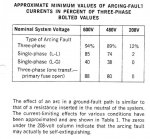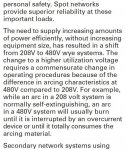That is utterly false. The tests in question were three parallel bus bars vertically oriented terminating into a block of insulating material. I don’t recall what they used as insulating material but I believe it’s FRP (glastic). The gap was varied from around 1/4 to 1 inch and arcing tine was monitored along with incident energy which is thermal radiation onto a copper calorimeter. Light and some other variables are monitored but mostly not reported. For some reason these barrier tests greatly enhance the output energy. Larger gaps increase the energy but also if the gap is too wide the arc is unsustainable. Enclosure size also makes a difference. These tests are intended to simulate industrial, not utility conditions. Most of the time in overhead line configurations utilities don’t have a problem with arc flash because it just shoots dow.n the line away from the worker. In generating plants it’s a bigger problem but equipment design and clearance rules tend to dictate towards working de-energized for the most part. Plus high fault current 208/120 systems in generating plants would be pretty rare. In fact one of the curious things about arc flash is it becomes less of a problem as voltage increases. It is mostly current dependent. It is mostly independent of voltage. Except that where tens of kA of fault current is not unusual at 208, 480, and 600, it is pretty rare at 13.5 kV and above because high AIC equipment gets crazy expensive.


